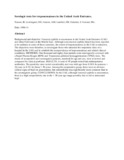| dc.description.abstract | The study is purpose was to identify the avoidable factors responsible for the high maternal mortality in the Pumwani Maternity Hospital in Nairobi, Kenya and to determine how the available facilities could be used to reduce the mortality. A retrospective study of maternal deaths was carried out at the hospital for the period 1975-1984. During this period, there were 223,111 births and 150 maternal deaths, giving an incidence of maternal mortality of 67.2/100,000 births. Eclampsia and severe preeclampsia, puerperal sepsis, ruptured uterus, and postpartum hemorrhage were among the leading causes of maternal deaths. The authors also concluded that the following factors contributed to the increased maternal mortality: high maternal age; primigravidy; grandmultiparity; lack of good antenatal, intranatal, and postnatal care; lack of investigations; lack of good transfusion services; lack of better skilled anesthetic staff; and lack of discipline among the medical personnel. | en |

